#costa rican warbler
Explore tagged Tumblr posts
Text
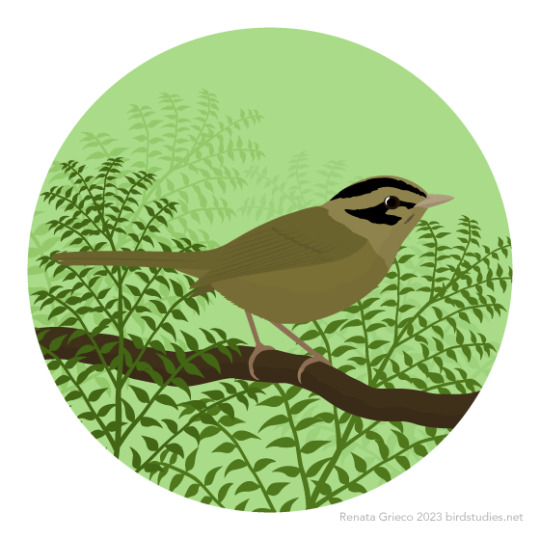
August 14, 2023 - Costa Rican Warbler (Basileuterus melanotis) Found in parts of Costa Rica and western Panama, these warblers live in and around mountain forests. They feed on insects, foraging in the understory in pairs and small groups and often joining mixed-species flocks. Only one of their nests has been described, it was domed with a side entrance and constructed from dry leaves, twigs, live fern leaves, grass, roots, and moss. Females build the nests and incubate the eggs and males help care for the chicks.
70 notes
·
View notes
Text
Warbler Showdown; Bracket 4, Poll 5


Rufous-capped Warbler (Basileuterus rufifrons)
IUCN Rating: Least Concern
Range: most of the range is in Mexico, extending south into Guatemala and sometimes appearing into Texas or Arizona
Habitat: dry-scrub, brushy ravines, open woodland, and early second growth or forest edges. Found from lowlands to 2500m
Subspecies: 5
Costa Rican Warbler (Basileuterus melanotis)
IUCN Rating: (not ranked)
Range: mountain range of Costa Rica and Panama
Habitat: submontane and lower montane humid forests in subtropical zones, as well as forest edges and well-developed second growth; from 600-2100m
Subspecies: None* (used to be a subspecies of Three-striped Warbler)
Image Sources: Rufous (Adam Jackson) CRWA (David Hollie)
#NWW Showdown#rufous capped warbler#costa rican warbler#black eared warbler#basileuterus#parulidae#passeriformes#animal poll#bird poll
5 notes
·
View notes
Text
13 Coolest International Destinations You Can Visit Without a Passport
YOU DON'T NEED A STAMP TO EXPLORE THESE SURPRISING GETAWAYS.

When it involves traveling overseas, there's one essential thing you usually got to bring: a passport. But did you recognize that you simply can attend areas outside of the mainland us without a blue book? (And we're not talking Hawaii or Alaska!) From a tropical paradise in Central America to family-friendly islands across the Caribbean, there are a couple of secret places you'll visit without a passport—and we're here to inform you exactly the way to get there. So, read on, and determine where you'll skip the stamp on your next international vacation.
1 Montego Bay, Jamaica
Montego Bay is possibly the foremost popular tourist destination in Jamaica and a serious cruise liner port. Hit the "Hip Strip," formally referred to as Gloucester Avenue, for shops, art galleries, and colorful cafés. But, of course, you're in Jamaica, so do not forget the beach! Doctor's Cave Beach is that the hottest choice because of its turquoise water perfect for snorkeling. and every one these wonderful Jamaican attractions are often visited without a passport if you're traveling by water. If you're on a cruise that begins and ends within the states, all you would like maybe an occident Travel Initiative-approved document, sort of a certificate and government-issued ID, or an enhanced driver's license.
2 Cabo San Lucas, Mexico
Cabo San Lucas is found below the state of California, down on the southern tip of the Lower California peninsula in Mexico. This beautiful beach resort destination is understood as a favorite amongst the celebs for its proximity to Hollywood. you'll go there year-round and possibly see celebrities like George Clooney, Jennifer Aniston, or maybe Justin Bieber himself. Hit The Spa at Las Ventanas if you would like to urge a Jennifer Lopez-approved glow, and eat fresh at Flora Farms like Adam Levine. and fortunately, consistent with the Los Cabos Airport Immigration regulations, Americans don't need a passport to go to this beautiful destination. Instead, you'll use a certificate, voter registration card, citizenship card, or certificate of naturalization alongside a legitimate photo ID.
3 Puerto Limon, Costa Rica
You may think there is no way you're stepping into Costa Rica without a passport, seeing as it is a country in Central America—but re-evaluate. Many Miami- or San Diego-based cruises sail bent Puerto Limon, one among the most important cities on the coast of Costa Rica. Here, you'll explore the city's untouched nature by taking an open-air tram ride through the Veragua Rainforest or taking a pontoon boat through the Tortuguero Canal. And as a crop-heavy area, don't leave on faith out an area Costa Rican plantation, where you'll see how items like bananas, chocolates, or cacao beans are selected, harvested, and packed for export.
4 Belize City, Belize
You better believe you'll love Belize, even without a passport. This city in Belize (just like its Costa Rican cousin Puerto Limon) is accessible through cruises out of the states, from cities like New Orleans and Miami. And while Belize isn't known for its beaches, per se, here you'll explore the Belize coral reef, which hosts diverse, exotic marine life. But what you absolutely cannot afford to miss in Belize is that the Mayan ruins. the foremost popular is Altun Ha, located just 3o miles northwest of Belize City. For thousands of years, the Mayans occupied this space, and core structures were restored so that today, tours could take visitors to the present historic landmark.
5 Roatán, Honduras
Located off the coast of Honduras, Roatán is an island called in the Caribbean. But unlike other Caribbean destinations, this one offers paradise without the high tag. Around 30 miles long, this small island may be a popular retirement destination thanks to its exotic, yet laid-back tropical nature. And its best secret? it is a hot spot for skin diving. The island is surrounded by the Mesoamerican Reef, a subculture of coral reefs, mangroves, and magnificently unique marine life. While you will need a passport to urge there by plane, countries like Honduras are "waiving the need for cruise passengers unless those passengers start or end their voyage there." So as long as you're on a closed-loop cruise that starts and ends within the states, you're liberal to explore paradise sans passport.
6 Saipan, Northern Mariana Islands
The Northern Mariana Islands have the simplest of both worlds: Scenic oceans and mountainous landscapes. As a commonwealth of the U.S., the 14 islands that structure the Northern Mariana Islands are located within the northwestern Pacific on the brink of Guam, another unincorporated territory. Most of the population lives on Saipan, the most important island. you'll either visit one among its breathtaking beaches like Micro Beach or experience an off-road adventure to the rocky Forbidden Island. But the pièce de résistance is that the Banzai Cliff, a historic war II area on the northern tip of the island. As an area for both reflection and paying respects, the scenery off this cliff is breathtakingly beautiful. And a bit like Guam, per the U.S. Customs and Border Protection's Carrier Information Guide, U.S. citizens who travel directly between the states and one among the territories "without touching a far off port or place," aren't required to present a passport.
7 Hamilton, Bermuda
Nestled within the middle of Bermuda is Hamilton, the island's capital. the town is understood for its pastel-colored buildings that line the harbor and house beach-chic boutiques and native restaurants. Visit the town Hall and humanities Centre for a few fascinating 17th- and 18th-century European paintings or the Bermuda Underwater Exploration Institute if you are looking for marine exhibits and ocean artifacts. But if you would like to travel to the simplest a part of Bermuda, you will have to travel across the town to Horseshoe Bay Beach—one of the world's most Instagrammable beaches, with blush pink sand and crystalline water. to urge here without a passport, take a closed-loop Royal Caribbean cruise from Cape Liberty, New Jersey.
8 Tumon, Guam
As an unincorporated U.S. territory, Guam is probably the furthest American-based place you'll visit, nestled within the Philippine Sea near Australia and South Asia. Tumon is found on the northwest coast of the territory, referred to as the middle of Guam tourism. There you'll visit UnderWater World, one among the most important tunnel aquariums within the world. or maybe take a visit to Punta Dos Amantes, a clifftop destination with scenic ocean views. And while having a passport is suggested for anyone traveling to Guam, there are some loopholes for U.S. citizens where they'll be ready to get out of it. Videos say Americans can visit the world passport-free if traveling directly from the mainland, Alaska, or Hawaii, and that they have any proof of citizenship sort of a certificate or certificate of naturalization.
9St. John, U.S. Virgin Islands
Located within the Caribbean, St. John is that the smallest of the U.S. Virgin Islands, but it is the perfect destination for anyone who loves natural beauty. Nearly two-thirds of the island is haunted by Mary Islands park, which shelters forests filled with many colorful birds from cuckoos to warblers and hummingbirds. But when you are not getting your forest fill, visit the gorgeous Trunk Bay beach, which has sugar soft sand and a treasured underwater snorkeling trail. Like most U.S. territories, you do not need a passport to travel here, but the U.S. Virgin Islands tourist center recommends carrying a raised-seal certificate or government-issued photo ID as you would possibly get to "show evidence of citizenship."
10 Montreal, Canada
Contrary to popular belief, as long as you're traveling by land or sea—so as an example, in your car—you aren't required to point out a U.S. passport thanks to the occident Travel Initiative. Instead, you ought to carry along proof of your citizenship and a legitimate photo ID. But if that creates you nervous, there are closed-loop cruises that begin from various New England cities and sail to Montreal. This French-speaking Canadian city is as close as you'll get to Europe without a passport. Here, you'll enjoy French pastries like macarons or visit historic landmarks that rival those in Paris, just like the Notre-Dame Basilica of Montreal.
11 Nassau, Bahamas
The Bahamas is one of the foremost popular cruise destinations from the states, and like many who've gone known, you do not need a passport. because the capital of the Bahamas, Nassau is found off the shore of the mainland on its island. One feature that draws tourists is the pastel-colored Colonial buildings, just like the Government House which may be a bright shade of pink. But Nassau, of course, is not just about the buildings—it's about the beach retreats. Within the past few years, a mega-resorts opened in Nassau called Baha Mar. The 1,000-acre, $4.2 billion property is comprised of three hotels: the Grand Hyatt, SLS Baha Mar, and Rosewood Baha Mar. And when hunger strikes, breeze by The Cove at Atlantis for fresh seafood at Fish by chef José Andrés.
12 Vieques, Puerto Rico
Puerto Rico is perhaps the foremost well-known U.S. territory, so there is no got to stress over getting a passport before visiting. As long as you're directly traveling from the states or another territory, it isn't necessary. So while you're there, you ought to visit Vieques, a little Caribbean Island off the territory's eastern coast. This area offers secluded beaches, beautiful blue-green waters, and therefore the best part? Wild horses that just roam the countryside. But if that does not roll in the hay for you, visit Mosquito Bay, a bioluminescent bay that gives other-worldly views that can't be missed.
13 San Juan, Puerto Rico
Don't recoil from the mainland of Puerto Rico, however. San Juan, the capital and largest city, sits beautifully on its northern coast. If you are looking for a wild tropical trip, visit the Isla Verde resort strip, filled with buzzing bars, nightclubs, and casinos. need a more calm, historic vacation? Take a visit to Old San Juan, the center of colorful Spanish colonial buildings and historic landmarks like La Fortaleza, where the governor resides, or El Morro, a Spanish fort that dates back to the 1500s.
2 notes
·
View notes
Text

#6 Osa Peninsula, Costa Rica
Osa. For us, the word itself conjures up a sense of mysticism. Not many people call it home, making this enchanted peninsula a rare jewell for wildlife. And while stats tend to differ between various sources, all of them baffle. Take this one for example: it’s estimated that this tiny plot of land, amounting to only 0.0001% of the earth’s surface area, contains a staggering 2.5% of the planet’s bio diversity. The ratio is somewhat explainable when you consider the tropical rain forest in this part of the world embraces a mind-bending thirteen different ecosystems, from freshwater and marine systems, to dense elevated primary forests, sandy beaches, encompassing mangroves, and more. There’s all sorts of magic happening here. We’ll get back to some of the numbers in a short while.

As for the drive down to this Southwestern tip, it was unsurprisingly spectacular. Engulfed by the supercharged flora, we whizzed around the perimeter in a green blur, catching glimmers of the crystal blue Pacific from time to time. Before heading to our base for the upcoming few days, we first needed to pick up some reserves in the largest town in the region, Puerto Jimenez. With the stop off complete, and three days worth of food packed in the boot, we hurried on to a town call Dos Brazos, waving goodbye to phone connection, WiFi, and convenience stores. Dos Brazos was once a bustling gold mining village, however, it now embraces a more ecologically responsible and sustainable vision. As a gateway to Corcovado National Park, growing eco-tourism opportunities have shown this sleepy village how conservation efforts can benefit the community, providing jobs and a healthier environment. It was like stepping back in time on entry. The pace of life is slow and there’s a feeling of balance and harmony that’s clearly been orchestrated by the abundant natural beauty in the area. The rough road through the town didn’t last long, and under instructions from our host we continued off road at what appeared to be a dead end, pushing our car to its limits.
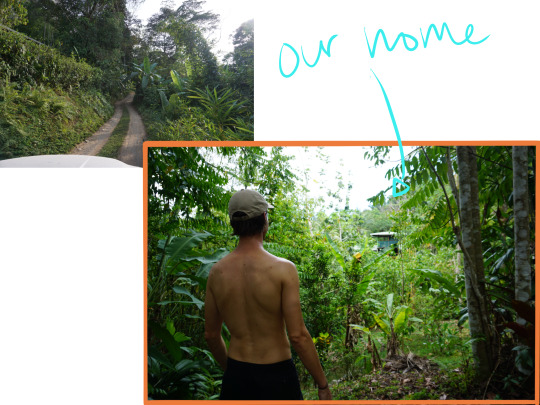
Within five minutes we’d landed at the idyllic home and gardens of Casa Aire Libre. Perched above Rio Tigre and surrounded by breathtaking greenery, this open aired home would prove to be a once in a lifetime abode for us both. We were finishing Costa Rica in style.

The home came equipped with an enormous kitchen suitable for any top chef, multiple hammocks and air chairs, a private garden with jungle paths, and a master bedroom up on a third floor up at tree level. We happily pottered about our new surroundings until the sunlight died on us, celebrating our first evening with a glass of vino and huge spread of various different tropical foods.
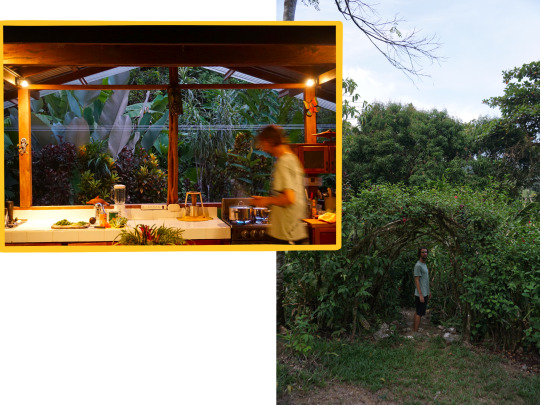
A booming chorus of bird calls coupled with a deep red backdrop from the sun rise was something to behold the next morning. Alarm clocks are now redundant to us, as we’ve become attune to nature’s cues and wake up calls. Our first full day in Osa was all about acclimatising and taking things slow. The expansive grounds and many amenities of our temporary home meant we had ample amounts of paths to explore, wildlife to admire, and foods to feast on. Maybe it was just the novelty of it, but the removal of walls in an environment like this felt like we could unconsciously absorb even more of Mother Nature while simply sat relaxing in our new home. Sometimes, however, there are more obvious physical encounters that come from having no barriers. As the power of the sun waned we went to grab a layer to put on. Lifting a t-shirt, a sizeable and startled wolf spider (we think) jumped off and perched itself on a nearby shelf. After much commotion, we let the spider be, and observed a plethora of other passers-by that evening, from tree frogs, to oversized clumsy flying beetles and the odd giant moth. We were truly in the thick of it.
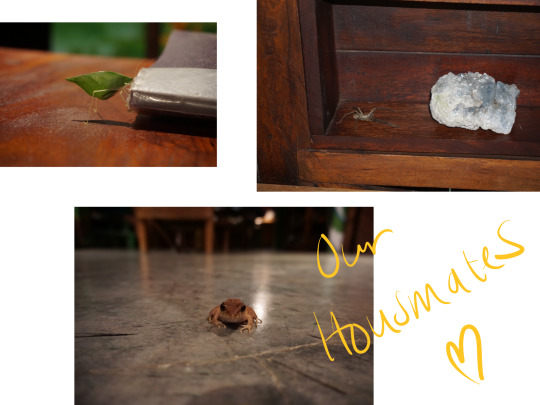
Our location in the foothills of the extremely important Corcovado National, which protects over 50% of the forest in the area, meant we were walking distance to a network of incredible jungle trails. However, the park itself is only accessible with a guide, and that was a little out of our price range. Fortunately for us, the nearby Bolita Rainforest Hostel has created some its own alternative self-guided options on the fringes of the park.
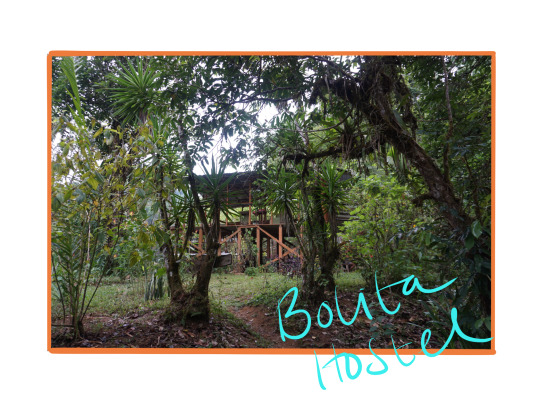
Bolita has to be one of the hardest hostels in the country to get to. It required a 30 min strenuous hike from our home through dense, shady forest, and it wasn’t like we were staying in a connected place! The owner, an American naturist and nudist enthusiast, set up the hostel seventeen years ago. During this time span the hostel has forged out approximately fifteen kilometers worth of trails through sixty plus hectares of rainforest. On entry to the hostel we paid a small fee for path maintenance and examined the rough map of routes. We were told to keep our eyes peeled for snakes, of which there are many in this part of the world. The simple rule to abide by; keep your eyes fixed on the ground when moving. Be stationary when looking up.

Briefing complete, we marched on to start the first of many trails. Clothes optional was the message on the entry sign, but we kept our bits covered (mostly). We zigzagged along the various trails for hours, treading carefully along the way. The humidity was heavy, but cloud cover meant we enjoyed cooler temperatures compared to average. We encountered three fleeing snakes during the day. All our serpent friends were small and apparently non venomous. With such abundance of snake life, we also had the fortune of spotting one of their hunters, a laughing falcon. We watched from afar until the beautiful bird silently flew away.
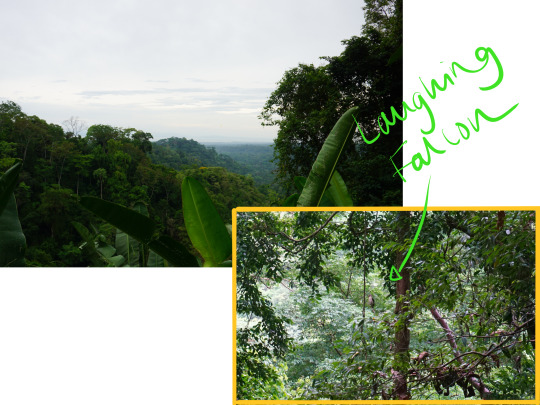
We followed routes to two separate waterfalls, which we’ve become so accustomed to. Eventually, we worked our way upwards to a remarkable viewpoint above the canopy outlooking the national park and spanning out towards the sea.

Within a moment of sitting down, we were greeted by two yellow throated toucans, who flew in to rest up on the tree directly opposite us. Such timely encounters couldn’t have been better created in our imaginations and the gifts kept occurring as we returned to the shade of the jungle. This time we stumbled across a gang of juvenile spider monkeys playing high up above our heads. One poor fella was missing a tail, but this didn’t seem to be holding him back. They swung between branches with such poise, until forming a small huddle where they proceeded to prune one another. We waved to the smallest in the group who sat alone still playing, and maybe it was a coincidence as it moved a nearby branch at the same time, but it felt like he or she gestured back to us. Their curious gaze in our direction filled our hearts with joy. Our tally for monkeys was now at three out of the four species in the country. Seeing this group of spider monkeys out in their natural environment was by far the most awe inspiring yet. What a day. One that left us wishing we had more time in the region.

We parted ways the next day, fitting in one final nature activity before leaving. Rising at 5 am, we met our bird guide for the morning, Rolando. After a quick cup of coffee we ventured out as light started to fill the sky. The starting point was conveniently on our doorstep. We wandered along our garden paths, the nearby banks of Rio Tigre, and outskirts of the town for three hours. In that time we spotted just short of fifty different bird species. For anyone that cares, we did our best to list those that we jotted down. You can find it at the bottom of the post. A few call outs are required. Ranking number one in our sightings was undoubtedly a pair of Spectacled Owls. Having never seen an owl of any sort in the wild, seeing these two hyper-tuned broad faced characters up close during daylight hours was rare. High fives were in order! Second on the list would have to be a fleeting sighting of the Turquoise Continga. The insane bright colours of this bird are hard to fathom. Third spot goes to go to a group of Scarlet Macaw that flew overhead while letting out their lung busting squawk. It was quite the conclusion to our stay in Osa. The energy of this living, breathing landscape left us gobsmacked. It’s home to between 4,000-5,000 species of vascular plants, more than 700 species of tree, nearly 400 species of birds, 124 different mammals, thousands of insects, and 115 species of reptiles. The list could go on. We knew we’d barely scratched the surface of the place, and departed ways knowing there were many reasons to one day return.
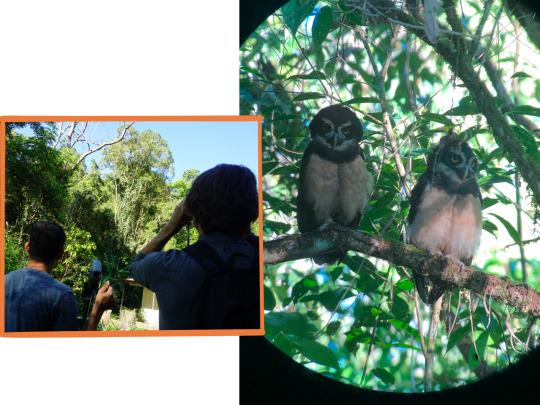
With only a two days left in Costa Rica, we decided to break up the drive back to San Jose with a stopover in the beach town of Uvita. That evening we strolled down Playa Uvita and entered Costa Rica’s youngest national park, Marino Ballena. The park is most coveted for its whale tail feature. This giant rock and sand formation reveals itself at low tide and from overhead looks just like the tail of a whale. It also happens to be a haven for humpbacks at specific times of the year. On the other side of the tail you find Playa Hermosa (where we’d enjoyed a siesta some days before). Sun down from the whales tail will long stick in our memory. The curtains were drawing in our Costa Rica adventure and the final scene was picture perfect. The journey, spanning over 1,800 kilometres, through four of the seven provinces, across volcanic highlands, rainforests, and sublime beaches, was everything we wanted and more.

Common Flycatcher Clay Coloured Thrush Blue Crowned Motmot Costa Rican Swift Red Crowned Woodpecker Rufous-tailed Hummingbird Buff-throated Saltator Turquoise Cotinga Green Honeycreeper (male and female) Streaked Flycatcher Southern Rough-winged Swallow Chestnut-sided Warbler Palm Tanger Slaty-tail Trogen Blue black Grosbeak Eastern Wood Peewee Spectacled Owl Scarlet Tanager Orange-chined Parakeet Scarlet Macaws Swallow-tailed Kite Scaly-breast Hummingbird Golden-hooded Tanager Burial-seed Eater Purple-crowned fairy Northern Bentbill Slate-headed Tody-flycatcher White-tipped Dove Great Currassow Black-cheeked Ant-tanager Tawny-winged Woodcreeper Black-hooded Antshrike River Siren Swansons Thrush Rose-eye Hawk Black-striped Sparrow Turkey Vultures Gartered Trogen Piratic Flycatcher Chachalaka Green Kingfisher Blue-ground Dove
2 notes
·
View notes
Text
Genus: Zeledonia

Wrenthrush (Anthony Batista)
This bird is a whole host of "why is it named that? its not that kind of bird!" Neither a wren (Troglodytidae), nor a thrush (Turdidae), nor is it a member of the wood-warbler family (Parulidae). In 2017, along with the host of movements and restructuring that affected a lot of varying bird families, the Wrenthrush finally got its proper sorting: It's own family, Zeledoniidae! Like many of the outlying songbird families, it can be hard to pinpoint their place in the "family tree" (or perhaps "order tree" would be a better way to describe it--). The current theory is that the Wrenthrush is likely related to Spindalidae and the Cuban Warblers (Teretistridae), as well as more distantly related to New World sparrows (Passerellidae) and New World blackbirds (Icteridae).
The etymology behind the name is a commemoration of a Costa Rican ornithologist named José Castulo Zeledón.
#Genus Feature#Not-Warblers#wrenthrush#passeriformes#zeledoniidae#i think its the genus name but I always think this bird should be from New Zealand
23 notes
·
View notes
Text

Costa Rican Warbler (Jeff Hapeman)
26 notes
·
View notes
Text

Costa Rican Warbler (Jaap Velden)
18 notes
·
View notes
Text

Costa Rican Warbler (Mason Maron)
16 notes
·
View notes
Text

Costa Rican Warbler By Johnathan Nightingale -Own work, CC BY-SA 3.0
11 notes
·
View notes
Text
Bracket 1: Setophaga-A
Grace's Warbler vs Barbuda Warbler
Hooded Warbler vs Myrtle Warbler
Golden-cheeked Warbler vs Olive-capped Warbler
Vitelline Warbler vs Chestnut-sided Warbler
Blackburnian Warbler vs Bay-breasted Warbler
Townsend's Warbler vs Yellow-throated Warbler
Cerulean Warbler vs Goldman's Warbler
Elfin-woods Warbler vs Tropical Parula
Black-throated Blue Warbler vs Kirtland's Warbler
Bracket 2: Setophaga-B
Pine Warbler vs Blackpoll Warbler
Bahama Warbler vs Arrowhead Warbler
Adelaide's Warbler vs American Restart
Palm Warbler vs St. Lucia Warbler
Yellow Warbler vs Plumbeous Warbler
Cape May Warbler vs Hermit Warbler
Prairie Warbler vs Black-throated Green Warbler
Magnolia Warbler vs Audubon's Warbler
Northern Parula vs Black-throated Gray Warbler
Bracket 3: Myiothlypis
Russet-crowned Warbler vs Citrine Warbler
Pale-legged Warbler vs White-lored Warbler (run-off)
Two-banded Warbler vs Flavescent Warbler
Gray-headed Warbler vs Santa Marta Warbler
Cuzco Warbler vs White-striped Warbler
Buff-rumped Wabler vs Choco Warbler
White-browed Warbler vs Riverbank Warbler
Gray-and-gold Warbler vs Black-crested Warbler
Gray-throated Warbler vs Roraiman Warbler
Bracket 4: Basileuterus
Fan-tailed Warbler vs Three-striped Warbler
Golden-browed Warbler vs Golden-crowned Warbler
Yungas Wabler vs Three-banded Warbler
Pirre Warbler vs Tacarcuna Warbler
Rufous-capped Warbler vs Costa Rican Warbler
Black-cheeked Warbler vs Chestnust-capped Warbler
Bracket 5: Geothlypis
Beldin's Yellowthroat vs Mourning Warbler
Kentucky Warbler vs Black-lored Yellowthroat
Common Yellowthroat vs Southern Yellowthroat
Gray-crowned Yellowthroat vs Altamira Yellowthroat
Bahama Yellowthroat vs Black-polled Yellowthroat
Olive-crowned Yellowthroat vs Hooded Yellowthroat
MacGillivray's Warbler vs Masked Yellowthroat
Bracket 6: Myioborus
White-fronted Whitestart vs Tepui Whitestart
Spectacled Redstart vs Brown-capped Whitestart
Yellow-crowned Redstart vs Painted Whitestart
Golden-fronted Whitestart vs Slate-throated Whitestart
Collared Whitestart vs Paria Whitestart
Saffron-breasted Whitestart vs White-faced Whitestart
Bracket 7: Leiothlypis & Cardellina
Virginia's Warbler vs Lucy's Warbler
Tennessee Warbler vs Nashville Warbler
Colima Warbler vs Orange-crowned Warbler
Red Warbler vs Pink-headed Warbler
Red-faced Warbler vs Wilson's Warbler
(solo/sit-out) Canada Warbler
Bracket 8: Vermivora, Parkesia, & Oreothlypis
Blue-winged Warbler vs Golden-winged Warbler
Northern Waterthrush vs Louisiana Waterthrush
Flame-throated Warbler vs Crescent-chested Warbler
(solo/sit-out) Bachman's Warbler
Bracket 9: Odd Ones Out
Semper's Warbler vs Prothonotary Warbler
Ovenbird vs Black-and-white Warbler
Swainson's Warbler vs Whistling Warbler
Connecticut Warbler vs Worm-eating Warbler
Bracket 10: Not-"Warblers"
Red-breasted Chat vs Yellow-headed Warbler
White-winged Warbler vs Olive Warbler
Green-tailed Warbler vs Grey-throated Chat
Yellow-breasted Chat vs Wrenthrush
Rose-breasted Chat vs Oriente Warbler
#NWW Showdown#I'm not tagging anything else bc that's too much work and they're already written out#masterpost
8 notes
·
View notes